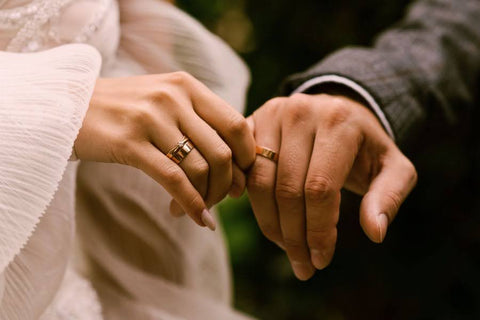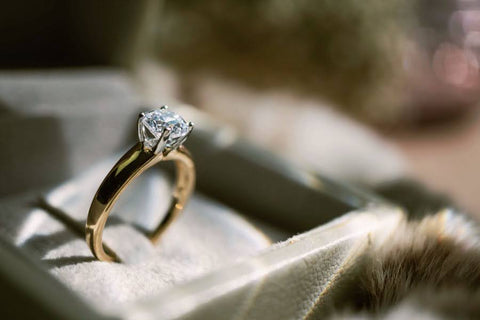by Jesús Zabala - 5 min read
When Were Wedding Rings Invented?
As many will assume, the tradition of exchanging wedding rings is a rooted practice that dates back centuries. As you all know, wedding rings symbolize the eternal bond between two individuals. But when were wedding rings invented? Why were rings invented?
This article traces wedding rings' history and origins, diving into their significance and evolution. We will offer detailed info exploring the presence of wedding rings from ancient civilizations to contemporary times.

Source: shutterstock.com / Photo Contributor: Kseniya Maruk
When Were Wedding Rings Invented?
To capture the essence of wedding rings, we first have to look into what was used before wedding rings as we know them today. Exploring the rich history of jewelry reveals that wedding rings date back nearly 5000 years to Ancient Egypt.
The Egyptians crafted rings from braided reeds and hemp, placing them on the fourth finger of the left hand, believed to house the 'vein of love' directly connected to the heart. This Egyptian tradition underscored the ring's symbolism as an eternal circle, representing an unbreakable promise of love and commitment.
The ancient Greeks adopted and adapted the Egyptian tradition, introducing rings made from leather, bone, or ivory. These rings continued to symbolize mutual love and obedience, with the majority used to depict Eros (the god of love). These primary forms of wedding rings laid the groundwork for future innovations in wedding jewelry.
The wedding ring tradition also found its way into the Roman Empire. Having conquered Greece, the Romans adopted the exchange of rings and introduced the use of metal bands.
The Romans also engraved their rings, introducing the concept of personalized matrimonial jewelry. These primary forms of wedding rings laid the groundwork for future innovations in wedding jewelry.
How did wedding rings evolve?
Since their initial introduction, wedding rings have undergone significant transformations. The Medieval period saw the introduction of precious gems into ring designs.
In Medieval Europe, each precious gem held a distinct significance. Diamonds symbolized steadfast strength; rubies were considered a symbol of passion, and sapphire symbolized the heavens.
The beginning of the Middle Ages saw the popularization of personalized wedding rings. Portrait rings and fede rings became a trend. Most of the rings exchanged during this period had the couple's faces or full figures engraved.
When Christianity was adopted as the official religion in Europe, these rings witnessed a change. A cross or Jesus’s image was engraved between the couple's faces on the rings, symbolizing the church's approval and blessing of the marriage.
Fede motifs were also popular within the Roman Empire. Around the 1600s, fede rings were altered and evolved into what is known today as the Claddagh ring. While initially fede rings represented a pair of interlocking hands, the Claddagh ring featured a heart, crown, or gem in the center between the hands.

Source: shutterstock.com / Photo Contributor: My Good Images
Renaissance and Enlightenment period
The Renaissance and Elizabethan era popularized poesy rings engraved with romantic poetry. Initially, poesy rings were first worn during the 15th century.
The first poesy ring designs had a bold design, and unlike more contemporary versions, the words were engraved on the outside instead of the inside. As poesy rings evolved, their design became simpler.
The Renaissance also saw the rise of gimmel rings. Unlike poesy rings, gimmel rings evolved from simple to more elaborate designs as goldsmithing skills progressed. Comprising two to three intertwined bands, gimmel rings beautifully represent how individual elements can be independent yet form a complete entity when united.
Traditionally, the bride and groom wore one part of the ring before their wedding, symbolizing their union by combining them on the big day. These rings often featured exquisite gemstones and detailed engravings enhanced by vibrant enamel. Those looking for simplistic engraved rings with a rugged appeal should check out our Raw Balinese ring.
History of Diamond Wedding Rings
Diamonds entered the wedding ring tradition as symbols of enduring strength and love. The first known diamond ring dates back to the late 100s AD in Rome. The first ever diamond ring belonged to a girl. However, no specific evidence can help specify if this ring was a gift of love or simply a symbol of status.
This is why many historians prefer saying that the 15th century marks the emergence of diamond engagement rings. The trend is traced back to European aristocracy, initiated by Archduke Maximilian of Austria in 1477.
According to the tale of the first documented diamond engagement, Archduke Maximillian of Austria ordered a diamond ring for his fiancée, Mary of Burgundy, setting a precedent among the European elite.
While these are the official claims of the American Gem Society, other sources suggest that the first documented diamond betrothal ring happened in Europe. More specifically, it occurred at the wedding of the Italian couple Costanzo Sforza and Camilla D'Aragona in 1475.
The tradition of diamond engagement rings
While diamond rings were used as engagement rings throughout the 17th century, the trend of tradition became most widespread in the 20th century. This happened largely due to De Beers' "Diamond is Forever" campaign.
In 1947, De Beers introduced its iconic phrase, "A Diamond is Forever," embedding the notion within the American consciousness that marriage, like a diamond, is meant to last indefinitely. This marked a shift towards diamond rings as the norm for engagements, with couples today seeking unique styles to express their individuality.

Source: shutterstock.com / Photo Contributor: Aleona
When did women start wearing diamond wedding rings?
As mentioned earlier, records show women began wearing diamond rings during the 15th century. The trend began among novelty figures, and the first diamond ring belonged to Duchess Mary of Burgundy. The ring Archduke Maximillian commissioned was made from small flat diamonds and also contained an ‘M’ initall.
Other women of novelty who received diamond wedding rings during the period that followed include Elizabeth I and Mary, Queen of Scots. White both were given diamond rings in the marriage proposal; neither of the suitors succeeded.
When did men start wearing diamond wedding rings?
Until the last century, wedding rings were predominantly worn by women. The practice of both partners wearing rings gained popularity during World War II.
Both American and European soldiers donned wedding bands as reminders of their spouses and sweethearts awaiting their return. This tradition persisted through the Korean War, after which the concept of men wearing wedding rings became widely accepted among civilians.
Conclusion
Exploring when wedding rings were invented reveals a fascinating human history through which we reflect on societies' evolving customs and traditions across millennia. So, when were wedding rings invented?
As discussed, the Egyptians were the first to exchange wedding rings in simple reed bands. This practice was adopted and transformed by the Greeks and Romans. Although we have little insight, we can better understand their timeline and evolution through the popularized customs of each period.
The practice evolved during the Medieval times, with intricate gold designs being exchanged between couples. The symbol of the love and commitment that bind couples together was last transformed within the 20th century with the diamond ring trend.
-
DESIGNED & HANDMADE IN BALI
-
FREE RESIZING FOR EVERY PIECE
-
FREE SHIPPING ON $150+ ORDERS
-
100% SAFE & SECURE CHECKOUT






















































